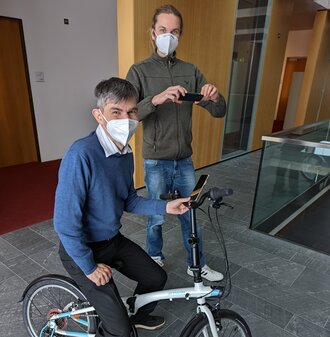
Prof. Dr. Oliver Taminé (front) and Johannes Deyringer from the "ABPA" research team at Furtwangen University can't wait to get on the bike themselves. Soon, the first bike path data will be analyzed at HFU.
New research project at Furtwangen University measures bike paths with the help of artificial intelligence
Whether it’s for a free time bike trip or a courier service: for many cyclists it would be very helpful if they knew what their route was like at the planning stage. Is there a dedicated bike path, or is it separated from the roadway by a marked lane? How wide is a mountain bike trail, and how many potholes can I expect on my route through town? The increase in bike traffic and the interest in such information is the core idea in the new "Automatic Bike Path Analysis" (ABPA) research project, launched at Furtwangen University in January 2022.
The idea for the research project came to Johannes Deyringer, a research assistant at the Faculty of Business Information Systems at HFU - on a bicycle, of course. At Furtwangen University, especially at the Institute for Mobility in Rural Areas (MIR), they have a lot of experience with research into mobility. " With Offenburg University and Outdooractive, we have succeeded in finding project partners that complement us perfectly," report project leaders Professor Dr Jochen Baier and Professor Dr Oliver Taminé. In a few weeks, things should be ready: test subjects will use smartphones to record short video sequences of bike paths, which will then be analysed in Furtwangen. "The AI will learn what the ground conditions are, where there are stones in the way or where the path is damaged," describes Johannes Deyringer. To this end, from "VeloKurier" in Freiburg to local ADFC groups, cyclists are getting on their bikes throughout the country in the name of research and collecting video footage.
The goal is to be able to supplement digital maps with the results of the research project. "Apart from the convenience and better planability of a route, we see above all a huge safety advantage," explains Silvan Kaspar, Director Cartography at Outdooractive. The project results are also relevant for those involved in bike logistics, enabling them to identify suitable delivery routes. "We’re also cooperating with municipalities on the project," says Professor Dr Baier, describing another aspect of the new project. In the future, for example, building authorities could be notified automatically if danger from damage has been detected on a bike path.
The ABPA project is being funded by the German Federal Ministry of Transport and Digital Infrastructure to the amount of € 455,340 as part of the mFUND innovation initiative and is scheduled to run for 24 months.
With the current boom in ebikes and cargo bikes, the research project is attracting a great deal of interest. "We've already received a huge number of inquiries from other research institutions in Germany and abroad, all of whom see synergies and want to exchange ideas with us," Deyringer reports, but the project is just getting started. It will probably be some time before he himself can collect data for ABPA in and around Furtwangen. Anyway, at the moment a digital map of the bike paths in the Black Forest would probably still advise against it, due to residual snow.
About the BMDV's mFUND:
As part of the mFUND innovation initiative, the BMDV has been funding data-based research and development projects for digital and connected mobility 4.0 since 2016. Project funding is supplemented by active professional networking between stakeholders from politics, business, administration and research and by making open data available on the mCLOUD portal. For more information, visit www.mFUND.de.
![[Translate to English:] [Translate to English:]](https://www.hs-furtwangen.de/fileadmin/_processed_/8/0/csm_PM_ABPA_Foerder_neu_a69c1a0387.jpg)